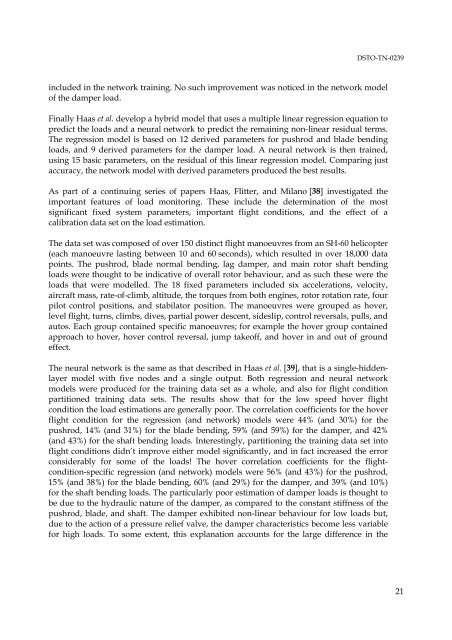Estimation of Structural Component Loads in Helicopters: A Review ...
Estimation of Structural Component Loads in Helicopters: A Review ...
Estimation of Structural Component Loads in Helicopters: A Review ...
Create successful ePaper yourself
Turn your PDF publications into a flip-book with our unique Google optimized e-Paper software.
DSTO-TN-0239<strong>in</strong>cluded <strong>in</strong> the network tra<strong>in</strong><strong>in</strong>g. No such improvement was noticed <strong>in</strong> the network model<strong>of</strong> the damper load.F<strong>in</strong>ally Haas et al. develop a hybrid model that uses a multiple l<strong>in</strong>ear regression equation topredict the loads and a neural network to predict the rema<strong>in</strong><strong>in</strong>g non-l<strong>in</strong>ear residual terms.The regression model is based on 12 derived parameters for pushrod and blade bend<strong>in</strong>gloads, and 9 derived parameters for the damper load. A neural network is then tra<strong>in</strong>ed,us<strong>in</strong>g 15 basic parameters, on the residual <strong>of</strong> this l<strong>in</strong>ear regression model. Compar<strong>in</strong>g justaccuracy, the network model with derived parameters produced the best results.As part <strong>of</strong> a cont<strong>in</strong>u<strong>in</strong>g series <strong>of</strong> papers Haas, Flitter, and Milano [38] <strong>in</strong>vestigated theimportant features <strong>of</strong> load monitor<strong>in</strong>g. These <strong>in</strong>clude the determ<strong>in</strong>ation <strong>of</strong> the mostsignificant fixed system parameters, important flight conditions, and the effect <strong>of</strong> acalibration data set on the load estimation.The data set was composed <strong>of</strong> over 150 dist<strong>in</strong>ct flight manoeuvres from an SH-60 helicopter(each manoeuvre last<strong>in</strong>g between 10 and 60 seconds), which resulted <strong>in</strong> over 18,000 datapo<strong>in</strong>ts. The pushrod, blade normal bend<strong>in</strong>g, lag damper, and ma<strong>in</strong> rotor shaft bend<strong>in</strong>gloads were thought to be <strong>in</strong>dicative <strong>of</strong> overall rotor behaviour, and as such these were theloads that were modelled. The 18 fixed parameters <strong>in</strong>cluded six accelerations, velocity,aircraft mass, rate-<strong>of</strong>-climb, altitude, the torques from both eng<strong>in</strong>es, rotor rotation rate, fourpilot control positions, and stabilator position. The manoeuvres were grouped as hover,level flight, turns, climbs, dives, partial power descent, sideslip, control reversals, pulls, andautos. Each group conta<strong>in</strong>ed specific manoeuvres; for example the hover group conta<strong>in</strong>edapproach to hover, hover control reversal, jump take<strong>of</strong>f, and hover <strong>in</strong> and out <strong>of</strong> groundeffect.The neural network is the same as that described <strong>in</strong> Haas et al. [39], that is a s<strong>in</strong>gle-hiddenlayermodel with five nodes and a s<strong>in</strong>gle output. Both regression and neural networkmodels were produced for the tra<strong>in</strong><strong>in</strong>g data set as a whole, and also for flight conditionpartitioned tra<strong>in</strong><strong>in</strong>g data sets. The results show that for the low speed hover flightcondition the load estimations are generally poor. The correlation coefficients for the hoverflight condition for the regression (and network) models were 44% (and 30%) for thepushrod, 14% (and 31%) for the blade bend<strong>in</strong>g, 59% (and 59%) for the damper, and 42%(and 43%) for the shaft bend<strong>in</strong>g loads. Interest<strong>in</strong>gly, partition<strong>in</strong>g the tra<strong>in</strong><strong>in</strong>g data set <strong>in</strong>t<strong>of</strong>light conditions didn’t improve either model significantly, and <strong>in</strong> fact <strong>in</strong>creased the errorconsiderably for some <strong>of</strong> the loads! The hover correlation coefficients for the flightcondition-specificregression (and network) models were 56% (and 43%) for the pushrod,15% (and 38%) for the blade bend<strong>in</strong>g, 60% (and 29%) for the damper, and 39% (and 10%)for the shaft bend<strong>in</strong>g loads. The particularly poor estimation <strong>of</strong> damper loads is thought tobe due to the hydraulic nature <strong>of</strong> the damper, as compared to the constant stiffness <strong>of</strong> thepushrod, blade, and shaft. The damper exhibited non-l<strong>in</strong>ear behaviour for low loads but,due to the action <strong>of</strong> a pressure relief valve, the damper characteristics become less variablefor high loads. To some extent, this explanation accounts for the large difference <strong>in</strong> the21
















